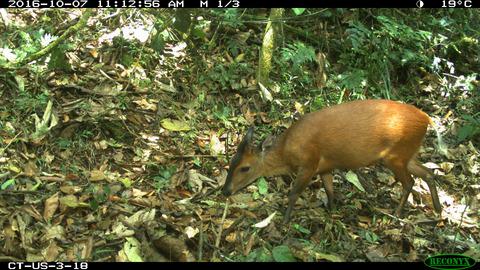当前位置:
X-MOL 学术
›
Anim. Conserv.
›
论文详情
Our official English website, www.x-mol.net, welcomes your
feedback! (Note: you will need to create a separate account there.)
Poor management in protected areas is associated with lowered tropical mammal diversity
Animal Conservation ( IF 2.8 ) Pub Date : 2019-07-20 , DOI: 10.1111/acv.12525 V. Oberosler 1, 2 , S. Tenan 3 , E. F. Zipkin 4 , F. Rovero 1, 5
Animal Conservation ( IF 2.8 ) Pub Date : 2019-07-20 , DOI: 10.1111/acv.12525 V. Oberosler 1, 2 , S. Tenan 3 , E. F. Zipkin 4 , F. Rovero 1, 5
Affiliation

|
Numerous protected areas (PAs) have been created worldwide to safeguard wildlife and other natural resources from anthropogenic threats such as habitat destruction and bushmeat hunting. However, conservation efforts in many tropical PAs are still inadequate, revealing deficiencies in management effectiveness. It is therefore important to quantify how different protection regimes impact wildlife within PAs. We investigated the differences between forest mammal communities in two ecologically comparable PAs in the Udzungwa Mountains (Tanzania) with contrasting management regimes. One is a well‐protected national park with efficient law enforcement; the other has suffered decades of inadequate protection, mainly resulting in high levels of illegal hunting. Using camera‐trapping data, we assessed the target communities in terms of species richness, functional composition (i.e. proportions of trophic guilds) and species‐specific occurrences, all while accounting for imperfect detection. We found striking differences between the two mammal communities: lower species richness, alteration in the trophic structure and reduced occurrence probabilities for most species in the forest with high disturbance. The difference in occurrence probability between the two PAs tended to be highest for larger‐bodied species. Our results show that strictly enforced legal protection is required to maintain diverse mammal communities in tropical forests under ever‐increasing anthropogenic threats. While PAs are the cornerstone of efforts to conserve tropical biodiversity, the future of biodiversity within them is closely tied to the effectiveness of enforcement.
中文翻译:

保护区管理不善与热带哺乳动物多样性降低有关
世界各地已经建立了许多保护区 (PA),以保护野生动物和其他自然资源免受栖息地破坏和丛林肉狩猎等人为威胁。然而,许多热带保护区的保护工作仍然不足,暴露出管理有效性的不足。因此,量化不同保护制度如何影响保护区内的野生动物非常重要。我们调查了 Udzungwa 山脉(坦桑尼亚)两个生态可比 PA 中森林哺乳动物群落之间的差异,并采用不同的管理制度。一个是保护良好、执法高效的国家公园;另一个则遭受了数十年的保护不足,主要是非法狩猎的严重程度。使用相机捕捉数据,我们根据物种丰富度评估了目标群落,功能组成(即营养公会的比例)和特定物种的发生,同时考虑到不完善的检测。我们发现两种哺乳动物群落之间存在显着差异:物种丰富度较低,营养结构发生改变,森林中大多数物种的出现概率降低。对于体型较大的物种,两种 PA 之间的发生概率差异往往最高。我们的研究结果表明,在不断增加的人为威胁下,需要严格执行法律保护才能在热带森林中维持多样化的哺乳动物群落。虽然保护区是保护热带生物多样性努力的基石,但保护区内生物多样性的未来与执法的有效性密切相关。营养公会的比例)和物种特定的事件,同时考虑到不完善的检测。我们发现两种哺乳动物群落之间存在显着差异:物种丰富度较低,营养结构发生改变,森林中大多数物种的出现概率降低。对于体型较大的物种,两种 PA 之间的发生概率差异往往最高。我们的研究结果表明,在不断增加的人为威胁下,需要严格执行法律保护才能在热带森林中维持多样化的哺乳动物群落。虽然保护区是保护热带生物多样性努力的基石,但保护区内生物多样性的未来与执法的有效性密切相关。营养公会的比例)和物种特定的事件,同时考虑到不完善的检测。我们发现两种哺乳动物群落之间存在显着差异:物种丰富度较低,营养结构发生改变,森林中大多数物种的出现概率降低。对于体型较大的物种,两种 PA 之间的发生概率差异往往最高。我们的研究结果表明,在不断增加的人为威胁下,需要严格执行法律保护才能在热带森林中维持多样化的哺乳动物群落。虽然保护区是保护热带生物多样性努力的基石,但保护区内生物多样性的未来与执法的有效性密切相关。同时考虑到不完善的检测。我们发现两种哺乳动物群落之间存在显着差异:物种丰富度较低,营养结构发生改变,森林中大多数物种的出现概率降低。对于体型较大的物种,两种 PA 之间的发生概率差异往往最高。我们的研究结果表明,在不断增加的人为威胁下,需要严格执行法律保护才能在热带森林中维持多样化的哺乳动物群落。虽然保护区是保护热带生物多样性努力的基石,但保护区内生物多样性的未来与执法的有效性密切相关。同时考虑到不完善的检测。我们发现这两种哺乳动物群落之间存在显着差异:物种丰富度较低,营养结构发生改变,森林中大多数物种的出现概率降低。对于体型较大的物种,两种 PA 之间的发生概率差异往往最高。我们的研究结果表明,在不断增加的人为威胁下,需要严格执行法律保护才能在热带森林中维持多样化的哺乳动物群落。虽然保护区是保护热带生物多样性努力的基石,但保护区内生物多样性的未来与执法的有效性密切相关。营养结构的改变和高干扰森林中大多数物种的发生概率降低。对于体型较大的物种,两种 PA 之间的发生概率差异往往最高。我们的研究结果表明,在不断增加的人为威胁下,需要严格执行法律保护才能在热带森林中维持多样化的哺乳动物群落。虽然保护区是保护热带生物多样性努力的基石,但保护区内生物多样性的未来与执法的有效性密切相关。营养结构的改变和高干扰森林中大多数物种的发生概率降低。对于体型较大的物种,两种 PA 之间的发生概率差异往往最高。我们的研究结果表明,在不断增加的人为威胁下,需要严格执行法律保护才能在热带森林中维持多样化的哺乳动物群落。虽然保护区是保护热带生物多样性努力的基石,但保护区内生物多样性的未来与执法的有效性密切相关。我们的研究结果表明,在不断增加的人为威胁下,需要严格执行法律保护才能在热带森林中维持多样化的哺乳动物群落。虽然保护区是保护热带生物多样性努力的基石,但保护区内生物多样性的未来与执法的有效性密切相关。我们的研究结果表明,在不断增加的人为威胁下,需要严格执行法律保护才能在热带森林中维持多样化的哺乳动物群落。虽然保护区是保护热带生物多样性努力的基石,但保护区内生物多样性的未来与执法的有效性密切相关。
更新日期:2019-07-20
中文翻译:

保护区管理不善与热带哺乳动物多样性降低有关
世界各地已经建立了许多保护区 (PA),以保护野生动物和其他自然资源免受栖息地破坏和丛林肉狩猎等人为威胁。然而,许多热带保护区的保护工作仍然不足,暴露出管理有效性的不足。因此,量化不同保护制度如何影响保护区内的野生动物非常重要。我们调查了 Udzungwa 山脉(坦桑尼亚)两个生态可比 PA 中森林哺乳动物群落之间的差异,并采用不同的管理制度。一个是保护良好、执法高效的国家公园;另一个则遭受了数十年的保护不足,主要是非法狩猎的严重程度。使用相机捕捉数据,我们根据物种丰富度评估了目标群落,功能组成(即营养公会的比例)和特定物种的发生,同时考虑到不完善的检测。我们发现两种哺乳动物群落之间存在显着差异:物种丰富度较低,营养结构发生改变,森林中大多数物种的出现概率降低。对于体型较大的物种,两种 PA 之间的发生概率差异往往最高。我们的研究结果表明,在不断增加的人为威胁下,需要严格执行法律保护才能在热带森林中维持多样化的哺乳动物群落。虽然保护区是保护热带生物多样性努力的基石,但保护区内生物多样性的未来与执法的有效性密切相关。营养公会的比例)和物种特定的事件,同时考虑到不完善的检测。我们发现两种哺乳动物群落之间存在显着差异:物种丰富度较低,营养结构发生改变,森林中大多数物种的出现概率降低。对于体型较大的物种,两种 PA 之间的发生概率差异往往最高。我们的研究结果表明,在不断增加的人为威胁下,需要严格执行法律保护才能在热带森林中维持多样化的哺乳动物群落。虽然保护区是保护热带生物多样性努力的基石,但保护区内生物多样性的未来与执法的有效性密切相关。营养公会的比例)和物种特定的事件,同时考虑到不完善的检测。我们发现两种哺乳动物群落之间存在显着差异:物种丰富度较低,营养结构发生改变,森林中大多数物种的出现概率降低。对于体型较大的物种,两种 PA 之间的发生概率差异往往最高。我们的研究结果表明,在不断增加的人为威胁下,需要严格执行法律保护才能在热带森林中维持多样化的哺乳动物群落。虽然保护区是保护热带生物多样性努力的基石,但保护区内生物多样性的未来与执法的有效性密切相关。同时考虑到不完善的检测。我们发现两种哺乳动物群落之间存在显着差异:物种丰富度较低,营养结构发生改变,森林中大多数物种的出现概率降低。对于体型较大的物种,两种 PA 之间的发生概率差异往往最高。我们的研究结果表明,在不断增加的人为威胁下,需要严格执行法律保护才能在热带森林中维持多样化的哺乳动物群落。虽然保护区是保护热带生物多样性努力的基石,但保护区内生物多样性的未来与执法的有效性密切相关。同时考虑到不完善的检测。我们发现这两种哺乳动物群落之间存在显着差异:物种丰富度较低,营养结构发生改变,森林中大多数物种的出现概率降低。对于体型较大的物种,两种 PA 之间的发生概率差异往往最高。我们的研究结果表明,在不断增加的人为威胁下,需要严格执行法律保护才能在热带森林中维持多样化的哺乳动物群落。虽然保护区是保护热带生物多样性努力的基石,但保护区内生物多样性的未来与执法的有效性密切相关。营养结构的改变和高干扰森林中大多数物种的发生概率降低。对于体型较大的物种,两种 PA 之间的发生概率差异往往最高。我们的研究结果表明,在不断增加的人为威胁下,需要严格执行法律保护才能在热带森林中维持多样化的哺乳动物群落。虽然保护区是保护热带生物多样性努力的基石,但保护区内生物多样性的未来与执法的有效性密切相关。营养结构的改变和高干扰森林中大多数物种的发生概率降低。对于体型较大的物种,两种 PA 之间的发生概率差异往往最高。我们的研究结果表明,在不断增加的人为威胁下,需要严格执行法律保护才能在热带森林中维持多样化的哺乳动物群落。虽然保护区是保护热带生物多样性努力的基石,但保护区内生物多样性的未来与执法的有效性密切相关。我们的研究结果表明,在不断增加的人为威胁下,需要严格执行法律保护才能在热带森林中维持多样化的哺乳动物群落。虽然保护区是保护热带生物多样性努力的基石,但保护区内生物多样性的未来与执法的有效性密切相关。我们的研究结果表明,在不断增加的人为威胁下,需要严格执行法律保护才能在热带森林中维持多样化的哺乳动物群落。虽然保护区是保护热带生物多样性努力的基石,但保护区内生物多样性的未来与执法的有效性密切相关。









































 京公网安备 11010802027423号
京公网安备 11010802027423号